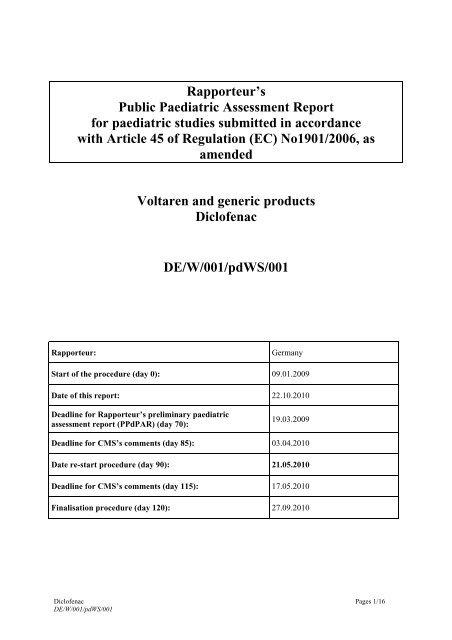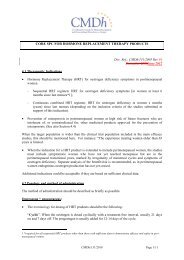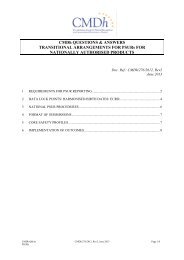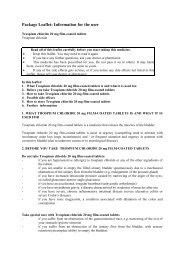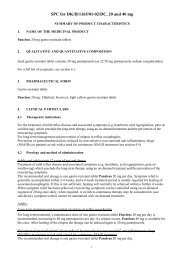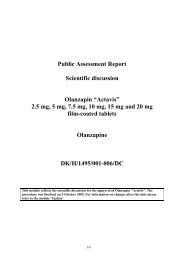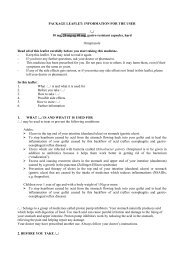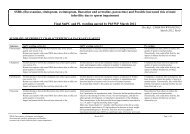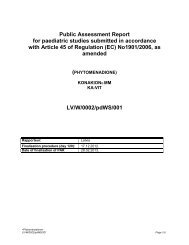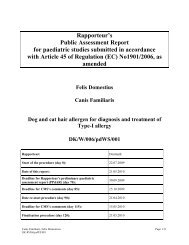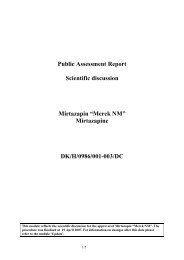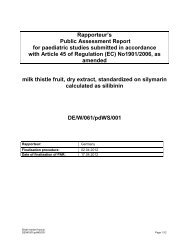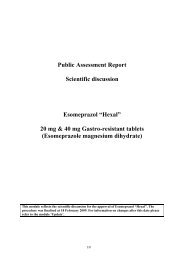1-03 DE 1058- Diclofenac Sodium- Public PdAR
1-03 DE 1058- Diclofenac Sodium- Public PdAR
1-03 DE 1058- Diclofenac Sodium- Public PdAR
Create successful ePaper yourself
Turn your PDF publications into a flip-book with our unique Google optimized e-Paper software.
Rapporteur’s<br />
<strong>Public</strong> Paediatric Assessment Report<br />
for paediatric studies submitted in accordance<br />
with Article 45 of Regulation (EC) No1901/2006, as<br />
amended<br />
Voltaren and generic products<br />
<strong>Diclofenac</strong><br />
<strong>DE</strong>/W/001/pdWS/001<br />
Rapporteur:<br />
Germany<br />
Start of the procedure (day 0): 09.01.2009<br />
Date of this report: 22.10.2010<br />
Deadline for Rapporteur’s preliminary paediatric<br />
assessment report (PPdPAR) (day 70):<br />
19.<strong>03</strong>.2009<br />
Deadline for CMS’s comments (day 85): <strong>03</strong>.04.2010<br />
Date re-start procedure (day 90): 21.05.2010<br />
Deadline for CMS’s comments (day 115): 17.05.2010<br />
Finalisation procedure (day 120): 27.09.2010<br />
<strong>Diclofenac</strong> Pages 1/16<br />
<strong>DE</strong>/W/001/pdWS/001
ADMINISTRATIVE INFORMATION<br />
Invented name of the medicinal<br />
product(s):<br />
INN (or common name) of the active<br />
substance(s):<br />
MAH (s):<br />
Pharmaco-therapeutic group<br />
(ATC Code):<br />
Pharmaceutical form(s) and strength(s):<br />
Voltaren and generic products<br />
<strong>Diclofenac</strong> sodium<br />
<strong>Diclofenac</strong> potassium<br />
<strong>Diclofenac</strong> resinate<br />
Topical diclofenac diethylamine<br />
Novartis<br />
M01AB05, M02AA15<br />
See Section IV<br />
Rapporteur’s contact person:<br />
Name: Durkhani Mangal<br />
Tel: +49 228 207-3605<br />
Email: durkhani.mangal@bfarm.de<br />
Non-clinical:<br />
Name: Dr. H.-K. Heim<br />
Tel: +49 228 207-3346<br />
Email: kheim@bfarm.de<br />
Name of the assessor(s)<br />
Clinical:<br />
Name: Dr. S. Reiter<br />
Tel: +49 228 207-3396<br />
Email: susanne.reiter@bfarm.de<br />
Bioavailability:<br />
Name: Dr. H. Potthast<br />
Tel: +49 228 207-5501<br />
Email: henrike.potthast@bfarm.de<br />
Biostatistics:<br />
Name: Dr. Jörg Zinserling<br />
Tel: +49 228 20742<strong>03</strong><br />
Email: jörg.zinserling@bfarm.de<br />
<strong>Diclofenac</strong> Pages 2/16<br />
<strong>DE</strong>/W/001/pdWS/001
ADR<br />
AE<br />
AUC<br />
ALT<br />
ALP<br />
AST<br />
BA<br />
BSA<br />
BCS<br />
BW<br />
CDS<br />
CHEOPS<br />
CL<br />
Cl/F<br />
Cmax<br />
CV<br />
<strong>DE</strong>A<br />
EC<br />
ECT<br />
d<br />
DMARD<br />
ENT<br />
EU<br />
F<br />
FDA<br />
GI<br />
h<br />
HLT<br />
ICH<br />
i.m.<br />
IMS<br />
i.v.<br />
JIA<br />
JRA<br />
Kd<br />
LPD<br />
M<br />
MA<br />
MAH<br />
MS<br />
NA<br />
NHANES<br />
NONMEM<br />
NSAID<br />
n<br />
OPS<br />
OTC<br />
peri-OP<br />
post-OP<br />
PK<br />
PMS<br />
p.o.<br />
LIST OF ABBREVIATIONS<br />
adverse drug reaction<br />
adverse events<br />
area under the curve of blood/plasma concentration versus time<br />
alanine transaminase<br />
alkaline phosphatase<br />
aspartate transaminase<br />
bioavailability<br />
body surface area<br />
Bio-pharmaceutics Classification System<br />
body weight<br />
Core Data Sheet<br />
Children’s Hospital of Eastern Ontario Pain Scale<br />
clearance<br />
oral clearance<br />
maximum blood/plasma concentration<br />
coefficient of variation<br />
diethylamine<br />
European Commission<br />
enteric coated tablets<br />
day<br />
disease modifying anti-rheumatic drug<br />
ear, nose or throat<br />
European Union<br />
female<br />
Food and Drug Administration (US Health Authority)<br />
gastrointestinal system<br />
hour<br />
MedDRA High Level Term<br />
International Conference on Harmonisation of Technical Requirements for<br />
Registration of Pharmaceuticals for Human Use<br />
intramuscular administration<br />
IMS Health database<br />
intravenous administration<br />
juvenile idiopathic arthritis<br />
juvenile rheumatoid arthritis<br />
dissociation constant<br />
The Cegedim Longitudinal Patient Database<br />
male<br />
marketing authorisation<br />
Marketing Authorisation Holder<br />
Member State<br />
not applicable<br />
National Health and Nutrition Examination Survey database<br />
Non linear Mixed Effect Modeling software<br />
non-steroidal anti-inflammatory drug<br />
number of subjects in study/treatment group<br />
objective pain scale<br />
over the counter / non-prescription medicines<br />
peri-operative<br />
post-operative<br />
pharmacokinetics<br />
post-marketing survailance<br />
per os (oral) administration<br />
<strong>Diclofenac</strong> Pages 3/16<br />
<strong>DE</strong>/W/001/pdWS/001
POM prescription only medicines<br />
PONV post-OP nausea and vomiting<br />
POP post-operative and post-traumatic pain<br />
PUMA paediatric-use marketing authorisation<br />
PRR proportional reporting ratio<br />
PT<br />
MedDRA Preferred Terms<br />
RCT randomized controlled trial<br />
SD<br />
standard deviation<br />
SIGN Scottish Intercollegiate Guidelines Network<br />
SMQ Standard MedDRA Query<br />
SmPC Summary of the Products Characteristics<br />
SOC MedDRA System Organ Class<br />
SSTC Skin and Soft Tissue Complications<br />
ST<br />
sulfotransferase<br />
T1/2 Half life<br />
THIN The Health Improvement Network Database<br />
Tmax time of maximum blood/plasma concentration<br />
t.i.d. ter in die / three times a day<br />
UK<br />
United Kingdom<br />
UGT glucuronosyltransferase<br />
VAS visual analogue scale<br />
VDS verbal descriptor scale<br />
Vd<br />
Volume of distribution<br />
WT<br />
weight<br />
yr<br />
year<br />
<strong>Diclofenac</strong> Pages 4/16<br />
<strong>DE</strong>/W/001/pdWS/001
IN<strong>DE</strong>X<br />
I. Executive Summary<br />
II. Recommendation<br />
II.1 Systemic application<br />
II.1.1 Indications ‘acute post-operative pain after minor surgery’ (POP) and ‘pain and<br />
fever related to infections of the ear, nose or throat (ENT), e.g. pharyngotonsillitis, otitis’<br />
II.1.2 JRA/JIA indication<br />
II.1.3 Safety Issues from post-marketing data<br />
II.1.4 Pharmacokinetic data<br />
II.2 Topical application<br />
II.3 Ophthamological application<br />
<strong>Diclofenac</strong> Pages 5/16<br />
<strong>DE</strong>/W/001/pdWS/001
I. EXECUTIVE SUMMARY<br />
Introduction<br />
Systemic formulations<br />
<strong>Diclofenac</strong> is a non-steroidal anti-inflammatory drug (NSAID) in use for over 30 years for the<br />
treatment of anti-inflammatory and painful conditions. It is available in several galenic formulations<br />
employing sodium salt (Voltaren), potassium salt (Cataflam – POM or Voltaren - OTC), free acid or a<br />
combination with colestyramine (“diclofenac resinate”), where diclofenac is bound on resinate as an<br />
ion exchanger.<br />
According to the CDS of the MAH Novartis, diclofenac is recommended for use in paediatric patients<br />
as a prescription only medicine (POM) in acute conditions such as post-traumatic, postoperative pain,<br />
inflammations and swelling, and severe painful inflammatory infections of the ear, nose or throat (as<br />
an adjuvant therapy), as well as in a chronic indication such as juvenile rheumatoid arthritis. Lower<br />
doses (up to 75 mg/day) of diclofenac are also available over-the-counter (OTC) in adolescents of 14<br />
years of age and over for the treatment of headache, dental pain, primary dysmenorrhoea (period pain),<br />
rheumatic pain, muscular pain and backache, relief of symptoms of colds and flu, including aches and<br />
pains and sore throat and reduction of fever.<br />
The data package, primarily submitted by one MAH (Novartis) under article 45 of the Paediatric<br />
Regulation, comprises preclinical studies in juvenile animals and clinical studies conducted in children<br />
and adolescents, together with non-clinical and clinical overview reports. The MAH also summarised<br />
the spontaneous suspected adverse event reports which have been received by the Company relating to<br />
use in children. The responses of the MAH to the LoQ (PrAR 17 th March 2009) comprise efficacy and<br />
safety data allocated to the 3 claimed indications of the systemic application: “acute postoperative<br />
pain” (POP), “pain and fever related to infections of the ear, nose or throat” (ENT) and “juvenile<br />
idiopathic arthritis” (JIA).<br />
Topical formulations<br />
<strong>Diclofenac</strong> diethylamine (INN: <strong>Diclofenac</strong> diethylammonium salt) is a non steroidal antiinflammatory<br />
drug (NSAID) designed for topical application (ATC code M02A A “Topical products<br />
for joint and muscular pain. Anti-inflammatory preparations, non-steroids for topical use”).<br />
<strong>Diclofenac</strong> diethylamine is recommended for the relief of pain and inflammation due to soft-tissue<br />
injuries, soft-tissue rheumatism and localised arthritic conditions in adults and in adolescents aged 12<br />
years and over.<br />
The data package, primarily submitted by one MAH (Novartis) under article 45 of the Paediatric<br />
Regulation, comprises pharmacokinetic data and some data from clinical studies, mainly conducted in<br />
adults. The MAH also summarised the spontaneous suspected adverse event reports which have been<br />
received by the Company relating to use in children. The response of the MAH to the LoQ (PrAR, 17 th<br />
March 2009) comprises mainly pharmacokinetic and safety data for the topical application.<br />
There is no uniformly justified paediatric posology for diclofenac-containing topical products in the<br />
approved SmPCs in EU countries.<br />
Development of procedure<br />
Following receipt of the Novartis response to the diclofenac Article 45 (Day 70) Draft Assessment<br />
Report on 9 th November 2009, BfArM (Rapporteur) issued its Day 90 Preliminary Assessment Report.<br />
Four member states (SE, NL, FR, UK) subsequently provided comments by Day 115 of the worksharing<br />
assessment procedure. SE agreed with the Rapporteur and had no further comments. NL, FR<br />
and UK provided detailed comments to the PrAR. On 1 st June 2010 the Rapporteur shared the<br />
concerned Members States comments together with the Rapporteur’s responses with Novartis, giving<br />
the applicant an additional one month clock-stop to address the remaining outstanding issues.<br />
Subsequently BfArM gave Novartis further opportunity for discussion: Novartis comments (30 th June<br />
<strong>Diclofenac</strong> Pages 6/16<br />
<strong>DE</strong>/W/001/pdWS/001
2010), response by BfArM (12 th July 2010), Novartis comments (2 nd August 2010), Rapporteurs<br />
responses (5 th August 2010), TC on 9 th August 2010), final comments Novartis (16 th August 2010).<br />
Summary of conclusions<br />
Systemic formulations<br />
After assessment of the MS comments received and extensive discussion with the MAH a revised<br />
posology for the oral solution, tablets and suppositories for the acute indications for systemic<br />
application is agreed.<br />
Based on the current divergent opinions across member states, a full harmonization of paediatric<br />
relevant parts of the product information for diclofenac for children with regard to the chronic<br />
indication juvenile idiopathic athritis (JIA) apparently cannot be achieved during this work sharing<br />
procedure. Further to the circulation of the Rapporteur’s Day 90 PrAR, three MS did not agree with<br />
the position of the Rapporteur that efficacy and safety of diclofenac in the indication JIA has not been<br />
sufficiently documented in controlled clinical studies. The Rapporteur maintains his opinion.<br />
The Rapporteur recommends implementation of a wording for the revised indications and posology in<br />
MSs via type IB variation. However, it is acknowledged that three MS are not in agreement (indication<br />
JIA) and that in this MS it may be appropriate to retain the product Information which is currently<br />
authorized or to implement only parts of the recommendation.<br />
Topical formulations<br />
After assessment of the MS comments received and extensive discussion with the MAH Novartis, a<br />
general age limitation for use of topical diclofenac in children below 14 years for flexible dosed<br />
topical formulations and below 16 years for fixed dosed topical formulations like plasters is<br />
recommended. Furthermore, a use as short-term treatment for children and adolescents is<br />
recommended by the Rapporteur.<br />
On basis of the limited data available for children for the topical application of diclofenac, only the<br />
acute pain indication is recommended by the Rapporteur for this age group.<br />
The Rapporteur recommends implementation of a wording for the revised indications and posology in<br />
the member states via type IB variation. However, based on the current divergent licensed indications<br />
in the member states and the divergent opinion of the MAH, the full harmonization of paediatric<br />
relevant parts of the product information for topical diclofenac for children and adolescents apparently<br />
cannot be achieved and for some member states it may be appropriate to retain the product information<br />
which is currently authorized or to implement only parts of the recommendation.<br />
Ophthalmological formulations<br />
The diclofenac-containing eye drops Voltaren ophtha and Voltaren ophtha sine are only licensed for<br />
use by adults. There is no need in the paediatric population. This is also recommended and justified by<br />
the Rapporteur (see PrAR 17 th March 2009). No further discussion is considered necessary with regard<br />
to the ophthalmological indication therefore no further information is included in this AR.<br />
II.<br />
RECOMMENDATION<br />
After evaluation of the presented data and of the comments received from MSs and Novartis, the<br />
Rapporteur is of the opinion that not all paediatric indications claimed in the CDS are in accordance<br />
with the scientific basis and the need in children. The MAH has agreed to a revised posology for acute<br />
indications, which is welcomed.<br />
In order to achieve a justified update and improvement of the available pharmaceutical formulations<br />
and an evidence-based posology for a treatment with diclofenac-containing products in children, the<br />
following measures are recommended (see below):<br />
<strong>Diclofenac</strong> Pages 7/16<br />
<strong>DE</strong>/W/001/pdWS/001
In general, the Rapporteur recommends an implementation of the wording for the revised indications<br />
and posology in MS via type IB variation.<br />
II.1<br />
II.1.1<br />
Systemic application<br />
Indications ‘acute post-operative pain after minor surgery’ (POP) and ‘pain and fever<br />
related to infections of the ear, nose or throat (ENT), e.g. pharyngotonsillitis, otitis’<br />
Rapporteur´s position<br />
Overall the data are considered sufficient to support the use of suppositories and tablets of strength<br />
12.5 mg and 25 mg for the indication ´short-term treatment of acute post-operative pain after minor<br />
surgery’ and ‘pain and fever related to infections of the ear, nose or throat (ENT), e.g.<br />
pharyngotonsillitis, otitis’ in children of different age with a weight-related daily dose of 2 mg/kg.<br />
Only pain relief in minor surgery is shown in the presented studies. Therefore, in the opinion of the<br />
Rapporteur, this issue should be reflected in the wording of the indication.<br />
Overall the data are considered sufficient to support a recommendation for 1.5 % diclofenac oral<br />
solution (diclofenac resinat drops) for the indication short-term treatment of POP and ENT in children<br />
of age 1 – 5 years with a weight-related daily dose of 1.5 mg/kg. For children under the age of 1 year,<br />
no separate data are available. The 1.5 % diclofenac oral solution is considered not therapeutically<br />
appropriate for use in children above 5 years of age because that would require a dosing of more than<br />
140 drops per day.<br />
The data presented for POP could be extrapolated to the indication ENT. It is therefore endorsed to<br />
give a joint dose recommendation for both acute indications ENT and POP. There are marketing<br />
authorisations for both indications in EU countries for children >14 years, concerning diclofenac<br />
potassium, and >1 year, concerning diclofenac sodium.<br />
As the proven frequency of the adult dose recommendation is 3 times daily for immediate release<br />
formulations, it is assumed that this will warrant also for children the best maintenance of pain relief<br />
with the best safety profile.<br />
The 50 mg tablet is considered not appropriate for use in children. The single dose for adults in acute<br />
pain is 12.5 – 50 mg diclofenac with a maximum of 75 mg per day. However, the 50 mg tablet when<br />
given three times daily exceeds the appropriate maximum daily dose in children >12 years. The<br />
suppositories have a comparatively high Cmax, insofar there could be an increased risk related with<br />
the 50 mg single dose. 150 mg daily is a proven dose for the treatment of rheumatic diseases in adults.<br />
In general (also for the 25 mg strength), gastro-resistant formulations may be not therapeutically<br />
adequate for a treatment of acute conditions because of their known delayed onset of efficacy.<br />
The doses (weight related daily dose of 1.5 mg/kg for oral solution and 2 mg/kg for suppositories and<br />
tablets) for the acute indications POP and ENT as recommended by the Rapporteur, taking into<br />
consideration MS and Novartis comments, are summarised in the table below (see under conclusion).<br />
Summary of comments received from MSs<br />
NL comment: In the indication pain and fever-related infections, the Rapporteur does not recommend<br />
25 mg tablets in children aged 9-11 years and 12-16 years.<br />
There is no reason why 25 mg tablets can not be effective in these 2 older age groups.<br />
The Rapporteur’s justification is that the studies were done only for a few days. However, based on<br />
clinical experience there is no reason why the use of diclofenac should be limited to a few days if the<br />
patient is being benefited. Instead, it is recommended to mention that treatment should be limited to<br />
the duration of pain and fever.<br />
<strong>Diclofenac</strong> Pages 8/16<br />
<strong>DE</strong>/W/001/pdWS/001
Furthermore, there is no logical explanation why children younger than 12 years should have a shorter<br />
treatment period in comparison to the older age group.<br />
In the indication acute post-operative pain after minor surgery, the Rapporteur does not recommend<br />
drops 1.5% in patients aged 1-5 years.<br />
Contrarily, the NL-Assessor considers this acceptable. There is no reason why drops 1.5% can work in<br />
pain and fever-related infections but not in post-operative pain.<br />
UK comment: In the indication pain and fever-related infections, the UK agrees with the Netherlands<br />
that 25 mg tablets should be indicated in children aged 9-11 years and 12-16 years.<br />
We agree with the Rapporteur that the duration of treatment should be only for short term use i.e. a<br />
few days (as in the UK SmPC for ibuprofen syrup).<br />
For the indication acute post-operative pain after minor surgery, the UK agrees with the Netherlands<br />
that the 1.5% drops should be indicated in patients aged 1-5 years.<br />
FR comment: It should be noted that the weight related daily doses of 2 mg/kg for these acute<br />
indications (POP, ENT) are in the range of the daily dose usually recommended in France for systemic<br />
diclofenac containing medicinal products.<br />
The proposed limitations of treatment duration (7 days / 14 days) are not endorsed. France considers<br />
that statement issued from the PhWVP “Keys Elements” procedure adopted by the CHMP in October<br />
2005 (Undesirable effects may be minimised by using the minimum effective dose for the shortest<br />
duration necessary to control symptoms) could be sufficient.<br />
France has no comment on the proposed acute indications (post operative pain, pain and fever related<br />
to infections of ENT) as they are not nationally granted.<br />
Summary of comments received from Novartis<br />
Novartis agrees with the position of the UK that the duration of treatment should be only for short<br />
term use.<br />
There is agreement on the wording for short term, symptomatic treatment of pain related to<br />
inflammatory infections of the ear, nose or throat (ENT).<br />
While acknowledging the limitation of the submitted clinical trial data in children, the positive benefit<br />
risk of diclofenac in the treatment of both post-operative and post-traumatic pain is well established<br />
worldwide in the adult patient population by controlled clinical trials.<br />
Although Novartis maintains its opinion regarding paediatric posology of tablets and suppositories 25<br />
and 50 mg, Novartis respects BfArM’s recommendation in this area.<br />
Under consideration of the divergent opinions of some member states and BfArM it may be a relevant<br />
and pragmatic solution to implement only some parts of the proposed harmonised paediatric posology,<br />
to maintain the nationally approved age limit for paediatric use or to retain the Product Information<br />
which is currently authorised in that particular Member State.<br />
With regard to the i.v. and i.m application in children Novartis welcomes the Rapporteur’s<br />
recommendation, which is in line with the current Company Core Data Sheet.<br />
With regard to the use of tablets 75/100 mg in children Novartis welcomes Rapporteur’s<br />
recommendation, which is in line with the current Company Core Data Sheet.<br />
<strong>Diclofenac</strong> Pages 9/16<br />
<strong>DE</strong>/W/001/pdWS/001
Conclusion<br />
On basis of the revised data submitted by Novartis the treatment of children with systemic diclofenac<br />
can be recommended for the acute indications POP and ENT as short-term treatment for specific<br />
formulations and strengths with a revised, joint posology.<br />
Dose recommendations for prescription-only acute indications<br />
The following dose recommendations are agreed (MS, Novartis) for POP and ENT indications and<br />
recommended by the Rapporteur:<br />
Oral Drops (1.5%):<br />
Children aged 1 - 5 years (min. 10 kg BW or over) should be given up to 1.5 mg/kg body weight per<br />
day in 3 divided doses, depending on the severity of the disorder.<br />
Suppositories (12.5 mg):<br />
Children aged 2 years (min. 13 kg BW) or over should be given up to 2 mg/kg body weight per day in<br />
3 divided doses, depending on the severity of the disorder.<br />
Tablets (25 mg), suppositories (25 mg):<br />
Children aged 9 years (min. 35 kg BW) or over and adolescents should be given up to 2 mg/kg body<br />
weight per day in 3 divided doses, depending on the severity of the disorder.<br />
Table: Dose recommendations for acute indications POP and ENT<br />
Single dose<br />
in number of drops,<br />
Body weight (kg)<br />
Dosage forms tablets, suppositories<br />
(corres-ponding age)<br />
(corresponding<br />
diclofenac dose)<br />
Maximum daily dose<br />
in number of dosage<br />
units (drops/tablets/<br />
suppositories<br />
10-19 kg<br />
(1-5 yr)<br />
13-19 kg<br />
(2 - 5 yr)<br />
20-44 kg<br />
(6-11 yr)<br />
35-44 kg<br />
(9-11 yr)<br />
45-55 kg<br />
(12-16 yr)<br />
Drops 1.5%<br />
10 – 20 drops<br />
(5–10 mg)<br />
12.5 mg supp 12.5 mg<br />
30 – 60 drops (in 3<br />
divided doses)<br />
12.5 mg bid - 12.5 mg<br />
tid<br />
12.5 mg supp 12.5 mg 12.5 mg tid<br />
25 mg supp/tab 25 mg 25 mg tid<br />
25 mg supp/tab 25 mg<br />
25 mg tid – 25 mg four<br />
times daily<br />
Solution for injection:<br />
With regard to the i.v. and i.m application a use in children and adolescents is not recommended by<br />
the Rapporteur which is in line with the current Company Core Data Sheet.<br />
Tablets 75/100 mg:<br />
With regard to tablets 75/100 mg a use in children and adolescents is not recommended by the<br />
Rapporteur which is in line with the current Company Core Data Sheet.<br />
Tablets/suppositories 50 mg:<br />
With regard to tablets/suppositories 50 mg a use in children and adolescents is not recommended by<br />
the Rapporteur which is respected by Novartis.<br />
<strong>Diclofenac</strong> Pages 10/16<br />
<strong>DE</strong>/W/001/pdWS/001
Wording of acute indications (prescription-only)<br />
The following wording is agreed (MS, Novartis) and recommended by the Rapporteur:<br />
Symptomatic, short-term treatment (children and adolescents) of<br />
- pain related to inflammatory infections of the ear, nose or throat, e.g. pharyngotonsillitis,<br />
otitis (ENT). In keeping with general therapeutic principles, the underlying disease should<br />
be treated with anti-infective basic therapy, as therapeutically appropriate. Fever alone<br />
without inflammatory component is not an indication.<br />
The following wording is agreed by the MS and recommended by the Rapporteur:<br />
Symptomatic, short-term treatment (children and adolescents) of<br />
- acute post-operative pain after minor surgery (POP).<br />
However, this latter indication is not fully agreed by Novartis. According to Novartis “post-traumatic<br />
pain, inflammation and swelling” should be maintained as additional sub-indications, which is not<br />
supported by the Rapporteur since data from clinical trials in children are not available for these subindications.<br />
Based on the current divergent opinions of the Rapporteur and the MAH concerning the subindications<br />
“treatment of post-traumatic pain, anti-inflammatory effects and improvement of<br />
swelling”, a full harmonization of paediatric relevant parts of the product information for diclofenac<br />
for children for this aspect apparently cannot be achieved.<br />
II.1.2<br />
JRA/JIA indication<br />
Rapporteur´s position<br />
The 25/50 mg enteric coated tablets and the 12.5, 25, 50, and 100 mg suppositories have marketing<br />
authorizations for JIA (JRA) in some European countries.<br />
However, in the opinion of the Rapporteur, the published evidence for a chronic treatment of JIA with<br />
diclofenac is at present considered not sufficient for a justified dose recommendation in children.<br />
Relevant information, as requested by the currently valid CHMP-guidelines (CPMP/EWP/556/95,<br />
CPMP/EWP/422/04), concerning a weight- and children´s age-related dose recommendation and, in<br />
particular, concerning long-term-treatment with diclofenac, could not be obtained from the submitted<br />
trials. On basis of the submitted post-marketing experience data there is concern that in particular<br />
long-term treatment with diclofenac in children could be related with an increased frequency of<br />
hepatic adverse events.<br />
In total, there are only data for 67 diclofenac-treated children available from controlled, double-blind,<br />
randomised trials. Differentiated data for single doses, frequency of application and total weightrelated<br />
daily doses are lacking. On basis of this data, an evaluation of the appropriate dose and a<br />
definition of a valid dose recommendation is considered problematic and an unnecessary<br />
overtreatment cannot be excluded.<br />
The children included in the mentioned studies were treated for 2 - 4 weeks. Long-term data beyond<br />
this treatment duration in order to elucidate the safety profile over time in children are scarce. The<br />
only data for long-term treatment may be obtained from one active controlled study where it is<br />
questionable how many of the initially 31 patients remained on treatment up to the final study duration<br />
of 8 years. However, In particular for long-term-treatment it is necessary to use a proven optimal dose<br />
in order to avoid unnecessary dose-related adverse effects.<br />
In conclusion, the Rapporteur is of the opinion that at present the clinical data base is too small for a<br />
positive general treatment recommendation for diclofenac in JIA.<br />
<strong>Diclofenac</strong> Pages 11/16<br />
<strong>DE</strong>/W/001/pdWS/001
Summary of comments received from MS:<br />
The UK raises a major objection to the deletion of the indication for juvenile systemic arthritis,<br />
especially for the tablet formulations, since use of diclofenac is established practice in the UK<br />
FR does not endorse the recommendations made by the Rapporteur because diclofenac products are<br />
authorised in France for paediatric rheumatic inflammatory diseases including JIA.<br />
NL does not endorse the recommendations made by the Rapporteur because the data of the doubleblind,<br />
placebo and active-controlled study with diclofenac enteric coated tablets (Haapasaari et al.,<br />
1983) are considerd sufficient to support the JIA indication in children, although the statistically<br />
significant results are based on a low sample size.<br />
SE endorsed the recommendation of the Rapporteur.<br />
Conclusions<br />
Based on the current divergent opinions across member states for the JIA indication, a full<br />
harmonization of paediatric relevant parts of the product information for diclofenac for children<br />
apparently cannot be achieved concerning this issue<br />
Further to the circulation of the Rapporteur’s PrAR, three MS were of the opinion that the JIA<br />
indication JIA and the posology currently recommended by the MAH should be maintained, while the<br />
Rapporteur is of the opinion that additional clinical data are required for a definition of the optimal<br />
diclofenac dose and a characterization of the long-term safety profile of diclofenac in this indication.<br />
The MAH acknowledges the suggestion of the Rapporteur to conduct a long-term observational study<br />
in patients with JIA, however, has not provided specific comments on this aspect during the article 45<br />
procedure, as requests for further studies are understood to be out of the scope of the article 45<br />
procedure. The MAH intends to seek clarification and provide further thoughts on this issue postprocedure.<br />
Changes in SmPC wording<br />
The MAH agreed to revise SmPC section 5.1 by including clinical data available for diclofenac use in<br />
treatment of JIA as follows:<br />
There is limited clinical trial experience of the use of diclofenac in JRA/JIA paediatric patients. In<br />
a randomised, double-blind, 2-week, parallel group study in children aged 3-15 years with<br />
JRA/JIA, the efficacy and safety of daily 2-3 mg/kg BW diclofenac was compared with<br />
acetylsalicylic acid (ASS, 50-100 mg/kg BW/d) and placebo - 15 patients in each group. In the<br />
global evaluation, 11 of 15 diclofenac patients, 6 of 12 aspirin and 4 of 15 placebo patients<br />
showed improvement with the difference being statistically significant (p < 0.05). The number of<br />
tender joints decreased with diclofenac and ASS but increased with placebo. In a second<br />
randomised, double-blind, 6-week, parallel group study in children aged 4-15 years with JRA/JIA,<br />
the efficacy of diclofenac (daily dose 2-3 mg/kg BW, n=22) was comparable with that of<br />
indomethacin (daily dose 2-3 mg/kg BW, n=23).<br />
II.1.3<br />
Safety Issues from post-marketing data<br />
Overall the adverse events reported for post marketing experience with systemic diclofenac in children<br />
and adolescents do not relevantly differ from those known for a therapy in adults. No completely new<br />
safety issues were identified.<br />
Severe AEs most frequently reported were anaphylactic reactions/anaphylactic shock, liver related<br />
disorders (such as hepatic failure, hepatitis, jaundice), gastrointestinal ulcer/perforations, Stevens-<br />
Johnson syndrome, Reye´s syndrome and agranulocytosis.<br />
<strong>Diclofenac</strong> Pages 12/16<br />
<strong>DE</strong>/W/001/pdWS/001
On basis of the available case reports, liver disorders including severe ones appear to occur relatively<br />
more frequently after >6 month diclofenac treatment in children >12 years than in adults. The reported<br />
relative frequencies for jaundice and hepatic function disorder seem to be increased in children<br />
compared to adults (2.6% of reported ADR versus 0.9%). In addition, increased plasma levels of<br />
marker enzymes for liver damage such as ALT (3.6% versus 1.7%) and AST (3.4% versus 1.1%) were<br />
reported more frequently in children than in adults.<br />
In addition, hypothermia appears to occur more frequently in context with diclofenac application in<br />
children 15 years.<br />
Belgium, Greece, Ireland and Italy: no dosage recommendation established for children and<br />
adolescents.<br />
Sweden > 16 years<br />
Norway > 18 years<br />
Most frequently, the topical use of diclofenac in children of an age below 12 years is not<br />
recommended or topical use of diclofenac in children and adolescents is completely contraindicated or<br />
no dosage recommendations have been established for them.<br />
Between the age of 12 and 18 years the systemic availability of topical diclofenac decreases and<br />
approaches the values known for adults (see figure below).<br />
<strong>Diclofenac</strong> Pages 13/16<br />
<strong>DE</strong>/W/001/pdWS/001
The MedDRA SOC AEs age related distribution is suggestive of a relative increase in systemic versus<br />
topical AEs in the group of adolescents (>12 years – 18 years) in comparison to adults. Whereas in<br />
both groups the proportion of skin adverse events (31.4% versus 37.5%) is comparable, the relative<br />
proportion of gastrointestinal disorders (15.7% versus 7.8%), injury, poisoning and procedural<br />
complications (11.8% versus 4.0%), nervous system disorders (5.9% versus 3.6%) and respiratory,<br />
thoracic and mediastinal disorders (7.8% versus 2.2%) appears to be higher in the group of adolescents<br />
than in adults.<br />
Initially, the MAH proposed for the topical application a general age limitation for children below 12<br />
years based on the established positive benefit/risk in the adult population, the pharmacokinetic data<br />
and post-marketing experience in adolescents.<br />
Summary of comments received from MS:<br />
NL did not agree with the treatment of children and adolescents by topical diclofenac at all. UK<br />
referred to similar topical products which are licensed for short-term treatment. SE agreed with the<br />
proposal of the Rapporteur.<br />
Conclusions<br />
<br />
Age limitation<br />
On basis of the available data, a general recommendation for treatment of children from 12 years on<br />
with topical diclofenac appears not justified. The age limitations (14 years for flexible-dosed<br />
formulations, 16 years for fixed-dosed formulations like e.g. medicated plasters) proposed by the<br />
Rapporteur are agreed by the MAH. This conservative approach appears reasonable taking into<br />
account that data from clinical trials are not available in this age group (
-Flexible-dosed formulations such as creams and gels:<br />
Children and adolescents below 14 years:<br />
There are insufficient data on efficacy and safety available for children and adolescents below 14<br />
years of age (see also contraindications section 4.3).<br />
Section 4.3:<br />
- Fixed-dose formulations such as medicated plasters:<br />
Children and adolescents:<br />
The use in children and adolescents aged less than 16 years is contraindicated.<br />
- Flexible formulations such as creams and gels:<br />
Children and adolescents:<br />
The use in children and adolescents aged less than 14 years is contraindicated.<br />
Wording of SmPC - Indication<br />
Taking into account the lack of relevant efficacy data and the fact that systemic availability of<br />
diclofenac appears to increase with decreasing age, it is considered appropriate by the Rapporteur to<br />
recommend only one acute indication which is considered clinically meaningful for this age group and<br />
supported by published efficacy and safety data for other NSAIDs. The following indication for<br />
children and adolescents is recommended by the Rapporteur and the wording is agreed in principle by<br />
the MAH.<br />
For short-term treatment’<br />
Local symptomatic relief of pain in acute strains, sprains or contusions following blunt trauma.<br />
However, Novartis pointed out that the proposed wording is only consistent with the one recently<br />
accepted within the national renewal in Germany. Consequently, based on the current divergent<br />
wording for this indication in the member states, the full harmonization of paediatric relevant parts of<br />
the product information for diclofenac for children and adolescents apparently cannot be achieved for<br />
this indication.<br />
In addition to this, the MAH is of the opinion that the indications “soft-tissue rheumatism pain” and<br />
“periarthropathy-related pain” which are approved in some MS should be maintained.<br />
However, data for a treatment of more chronic conditions such as soft-tissue rheumatism and<br />
periarthropathy-related pain in adolescents or children have not been submitted for topical diclofenac.<br />
Since specific data are not available for children and adolescents, these additional indications are not<br />
supported by the Rapporteur.<br />
Based on the current divergent licensed indications in the member states and the divergent opinion of<br />
the MAH, the full harmonization of paediatric relevant parts of the product information for diclofenac<br />
for children apparently cannot be achieved for this issue.<br />
Wording of SmPC - Additional information concerning consultation of a doctor<br />
The MAH agreed to include the following sentences into section 4.2 of the SPC/PIL:<br />
OTC topical diclofenac products:<br />
- For fixed-dose formulations such as medicated plasters:<br />
In children aged 16 years and over, if this product is required for more than 7 days for pain relief or if<br />
the symptoms worsen, the patient/parents of the adolescent is/are advised to consult a doctor.’<br />
<strong>Diclofenac</strong> Pages 15/16<br />
<strong>DE</strong>/W/001/pdWS/001
- For flexible-dosed formulations such as creams and gels:<br />
In children aged 14 years and over, if this product is required for more than 7 days for pain relief or if<br />
the symptoms worsen the patient/parents of the adolescent is/are advised to consult a doctor.’<br />
Topical diclofenac products for prescription:<br />
- For fixed-dose formulations such as medicated plasters:<br />
In children aged 16 years and over, if the symptoms worsen the patient/parents of the adolescent<br />
is/are advised to consult the doctor.’<br />
- For flexible-dosed formulations such as creams and gels:<br />
In children aged 14 years and over, if the symptoms worsen the patient/parents of the adolescent<br />
is/are advised to consult the doctor.’<br />
Wording of SmPC - Additional aspects<br />
With respect to an additional warnings concerning an increased risk for accidental intake (topical<br />
formulation) and potential undesirable systemic effects of topical diclofenac preparations in children,<br />
it is agreed to take up these points in the currently ongoing diclofenac PSUR worksharing procedure<br />
for reasons of competence.<br />
The following sentence is proposed to be included into section 4.8 of the SmPC/PIL, the proposal will<br />
be submitted by BfArM to the PSUR worksharing procedure Rapporteur DK:<br />
Systemic absorption of topically applied diclofenac is very low and the resulting diclofenac plasma<br />
levels are also very low compared with plasma levels following oral intake of diclofenac. The<br />
probability of systemic undesirable effects (such as e.g. gastrointestinal, hepatic or renal disturbances,<br />
bronchospasm) is thus very low following topical application compared with the frequency of<br />
undesirable effects associated with oral intake of diclofenac. If diclofenac is used on a large area of<br />
skin and for a prolonged period, however, undesirable systemic effects may occur.’<br />
II.3<br />
Ophthamological application<br />
<strong>Diclofenac</strong> eye drops are licensed for use in adults only. There is no need in the paediatric population.<br />
This is also recommended and justified by the rapporteur (see Pr<strong>PdAR</strong>).<br />
<strong>Diclofenac</strong> Pages 16/16<br />
<strong>DE</strong>/W/001/pdWS/001


